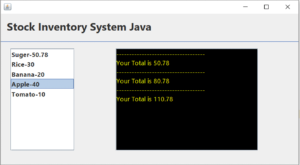Introduction to Java Inventory Management Systems
In today’s fast-paced business environment, effective inventory management is crucial. A Java inventory management system can streamline processes, and using user-friendly components like list boxes enhances user experience. This blog post explores how to implement an inventory management system using Java, with a focus on the practical application of list boxes.
Setting Up the Java Environment
Before we dive into coding, ensure you have the Java Development Kit (JDK) installed. You’ll also need an Integrated Development Environment (IDE) like Eclipse or IntelliJ IDEA to facilitate coding. With your environment ready, you can begin developing your inventory management system.
Implementing List Boxes in Your Java Application



Go through the video below paste code
double price,tot;
private void ListItemsValueChanged(javax.swing.event.ListSelectionEvent evt) {
if (evt.getValueIsAdjusting())
{
String selectedValue = ListItems.getSelectedValue();
if (selectedValue.equals("Suger-50.78")) {
price = 50.78;
} else if (selectedValue.equals("Rice-30")) {
price = 30;
} else if (selectedValue.equals("Banana-20 ")) {
price = 20;
} else if (selectedValue.equals("Apple-40")) {
price = 40;
}
else if (selectedValue.equals("Tomato-10")) {
price = 10;
}
tot += price;
// Append the total to the JTextArea
txtDisplay.append("-----------------------------------\n");
txtDisplay.append("Your Total is " + tot + "\n");
}
// TODO add your handling code here:
}I attached the video below How to make this System